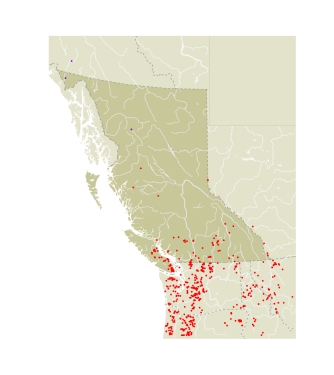AdultThe Western Meadow Fritillary is closest in appearance to the Meadow Fritillary but lacks the blunt forewing apex of the latter.
Immature StagesEdwards (1892) gave the only published account of the early stages. This paper has been overlooked by all subsequent workers, including Shepard (1975). The fourth instar larva is grey with a dark dorsal line and lower lateral lines, and the area between cross-marked with black; the basal stripe is red. The spines are russet, except those on the second and third thoracic segments and last abdominal segment, which are black. Edwards noted that this species is quite different from C. bellona. Mr. Koeble supplied eggs from Spokane, WA.
SubspeciesThe southern and central BC populations are the subspecies C.e. chermocki E. & S. Perkins, 1966 (TL: 2.9 mi. E Dolph, Yamhill Co., OR) (= borealis E. Perkins, 1973; = uslui Koçak, 1984), which ranges from northern coastal California north to New Aiyansh, BC (Shepard and Shepard 1974) and from southeastern BC to northwestern WY (Yellowstone). The populations in the Coast Ranges from Mt. Klapan north and the adjacent Alaska panhandle and Yukon are the new subspecies C.e. sigridae (described below). The type locality of the name borealis is in the Cascade Mountains of BC and was erroneously applied to all C. epithore populations from northern and eastern BC and southeast to central Idaho by E. Perkins. These interior populations in the southeast of BC are not separable from southwestern BC populations. Even if they were, the type locality of borealis is within the expected range of a western/Cascade subspecies, not a Rocky Mountain subspecies.
Clossiana epithore sigridae Shepard, new subspecies. In both males and females the spot between vein M1 and vein M2 in the postmedian row on the dorsal hindwings is elongate, not rounded as in other subspecies, and is pointed towards the base of the wing. The adjacent postmedian spot above vein M1 is usually also elongated. These elongated spots are not found on specimens of the other C. epithore subspecies unless the specimen is clearly an aberrant one. The basal portion of the ventral hindwings, inside the median band of dull yellow connected spots, is a uniform dark reddish brown. By contrast, in subspecies chermocki, this basal area is heavily overlaid by yellow scales to the point that the median row of yellow spots does not stand out. Males of subspecies sigridae (n = 23) have an average wing length of 18.2 mm, females (n = 12) 20.0 mm. This is significantly smaller than in even the closest populations (New Aiyansh) of subspecies chermocki, where males (n = 5) average 20.0 mm and females (n = 2) average 21.5 mm. Types. Holotype: male, BC, St. Elias Mts., Tats Lake, 770 m, 22 July 1992, leg. C.S. Guppy. A label "Holotype / Clossiana epithore / sigridae Shepard" is attached. The holotype is deposited in the Royal British Columbia Museum, Victoria, BC, CAN. Paratypes: 20 males, 8 females, same data (RBCM); 1 male, 1 female, same data (JHS); 1 male, 3 females, BC, Mt. Klapan Rd., km. 109, el. 1,400 m, 11 July 1989, leg. J. and S. Shepard (JHS).
